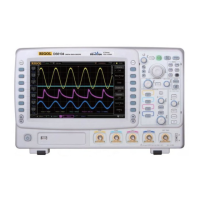RIGOL Chapter 2 Performance Verification Test
2-6 DS6000 Performance Verification Guide
8) Calculate the relative error of this vertical scale: |(Vavg1 - Vavg2) - (Vout1 -
Vout2)|/Full Scale × 100%.
9) Keep the other settings of the oscilloscope unchanged:
a) Set the vertical scale to 5 mV/div, 10 mV/div, 20 mV/div, 50 mV/div, 100 mV/div, 200
mV/div, 500 mV/div and 1 V/div respectively.
b) Adjust the output voltage of Fluke 9500B to 3 × the current vertical scale and -3 × the
current vertical scale respectively.
c) Repeat steps 3) to 7) and record the test results.
d) Calculate the relative error of each vertical scale: |(Vavg1 - Vavg2) - (Vout1 -
Vout2)|/Full Scale × 100%.
10) Turn off CH1. Test the relative error of each scale of CH2, CH3 and CH4 respectively using
the method above and record the test results.
2. DC gain accuracy test when the input impedance is 1 MΩ
1) Connect the active signal terminal of Fluke 9500B to CH1 of the oscilloscope, as shown in
the figure above.
2) Set the impedance of Fluke 9500B to 1 MΩ.
3) Output a DC signal with +6 mV
DC
voltage (Vout1) via Fluke 9500B.
4) Configure the oscilloscope:
a) Press CH1 in the vertical control area (VERTICAL) at the front panel to enable CH1.
b) Press CH1 Probe Ratio to set the probe attenuation ratio to “1X”.
c) Press CH1 Input to set the input impedance of CH1 to 1 MΩ.
d) Repeat d) to g) in step 4) in DC gain accuracy test when the input impedance is
50 Ω.
5) Test the relative error of each scale of CH1 (add the tests of 2 V/div and 5 V/div) according
to steps 5) to 9) in DC gain accuracy test when the input impedance is 50 Ω and
record the test results.
6) Turn off CH1. Test the relative error of each scale of CH2, CH3 and CH4 respectively using
the method above and record the test results.

